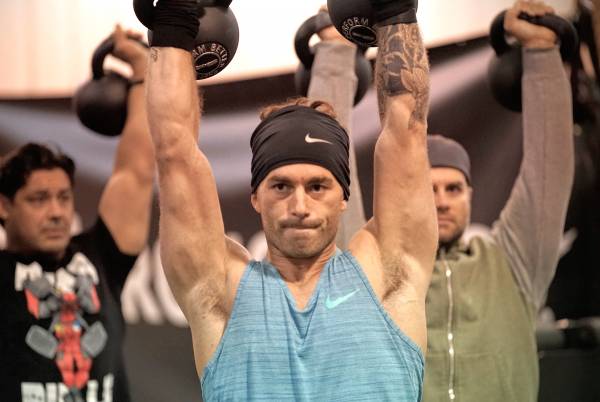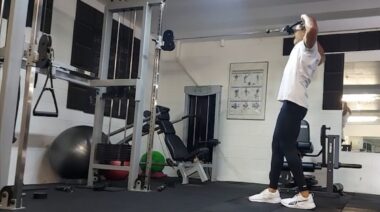The waiter’s walk might be one of your best tools to build shoulder stability and strength.
A waiter’s walk is performed by simply holding a weight overhead and walking. I recommend using a kettlebell, or two. A barbell with a snatch grip or jerk grip works great, too. Each variation offers different benefits. With one kettlebell, the obliques and spinal erectors get extra work stabilizing the body. The double kettlebell or barbell variations train the ability to lock out under load and require great mobility.
It is important to take care of the wrist in this movement. Take a look at the wrists in the picture below. If you push heavy weights overhead, your wrist should be as straight as possible. Allowing it to bend back can lead to wrist injuries. I see many people with wrist issues as they begin CrossFit. My best guess for why this happens is that they allow the wrist to bend back in catching the jerk and snatch. Wrist wraps are not the solution. Building a powerful connection between your hands and shoulder is.
Left: Proper grip and wrist position for a waiter’s walk; Right: Improper grip – not recommended
It’s great to practice heavy waiter’s walks, but getting the weight overhead can be a limiting factor. Any way you can get the weight overhead will work. For some, a Turkish get up followed by waiter’s walks might be best. Others might have to push press or jerk it into position.
The Benefits of Waiter’s Walks
Dan John has long advocated weighted walks as one of his five fundamental movements. The biggest benefit of waiter’s walks their ability to train the neural pattern needed to catch and hold a heavy load overhead, which is especially helpful for snatches and jerks.
Here are a few other benefits of the waiter’s walk:
- Strengthens the wrist – A straight wrist leads to a powerful grip and begins the connection between the weight and the ground. All parts of this connection need to be tight.
- Locks out the elbow – Beginners often fail Olympic lifts because they have soft elbows when they catch the weight. Try the waiter’s walk with a soft elbow and you will quickly learn why you need to lock out. Again, the lock out builds a solid foundation with the ground.
- Engages the lats and shoulder connection – Waiter’s walks teach you to pack the shoulder into the back. A simple but effective cue is to pull the shoulders back and down.
- Teaches variability under load – Walking strengthens the above connections. As you walk, you move the weight around. Your body corrects this movement and builds neural patterns in the process. This is an invaluable teaching technique and probably one of the reasons Dan John loves loaded carries.
How to Program Waiter’s Walks
The plan put forth by Pavel Tsatsouline and Dan John in Easy Strength makes sense – end each day with a loaded carry. Once or twice a week, the loaded carry can be the waiter’s walk. If you are doing Turkish get ups to get the weights up, you can add in a 25 meter walk between the get up and the get down.

Waiter’s walks force beginners to fix their weak links. If you do not have the thoracic or shoulder mobility, work on it at least once a week with Turkish get ups or waiter’s walks. Practice with one-arm waiter’s walk to start with.
Coaches can give cues, but the waiter’s walk provides direct feedback. As you walk, the weight bounces and moves. Each movement teaches the body how to counteract that force. This develops neural patterns and shoulder strength that are invaluable under load.
More on shoulder health:
- 7 Exercises to Optimize Shoulder Health With Kettlebells
- How to Crawl Your Way Back to Shoulder Health
- Avoid Shoulder Injury by Strengthening the Rotator Cuff
- New on Pulse Beat Fit Today
References:
1. John, Dan. Can You Go: Assessments and Program Design for the Active Athlete and Everybody Else. Santa Cruz, California: On Target Publications, 2015.
2. Tsatsouline, Pavel, and Dan John. Easy Strength: How to Get a Lot Stronger Than Your Competition-And Dominate in Your Sport. 1st edition. Dragon Door Publications, 2011.






